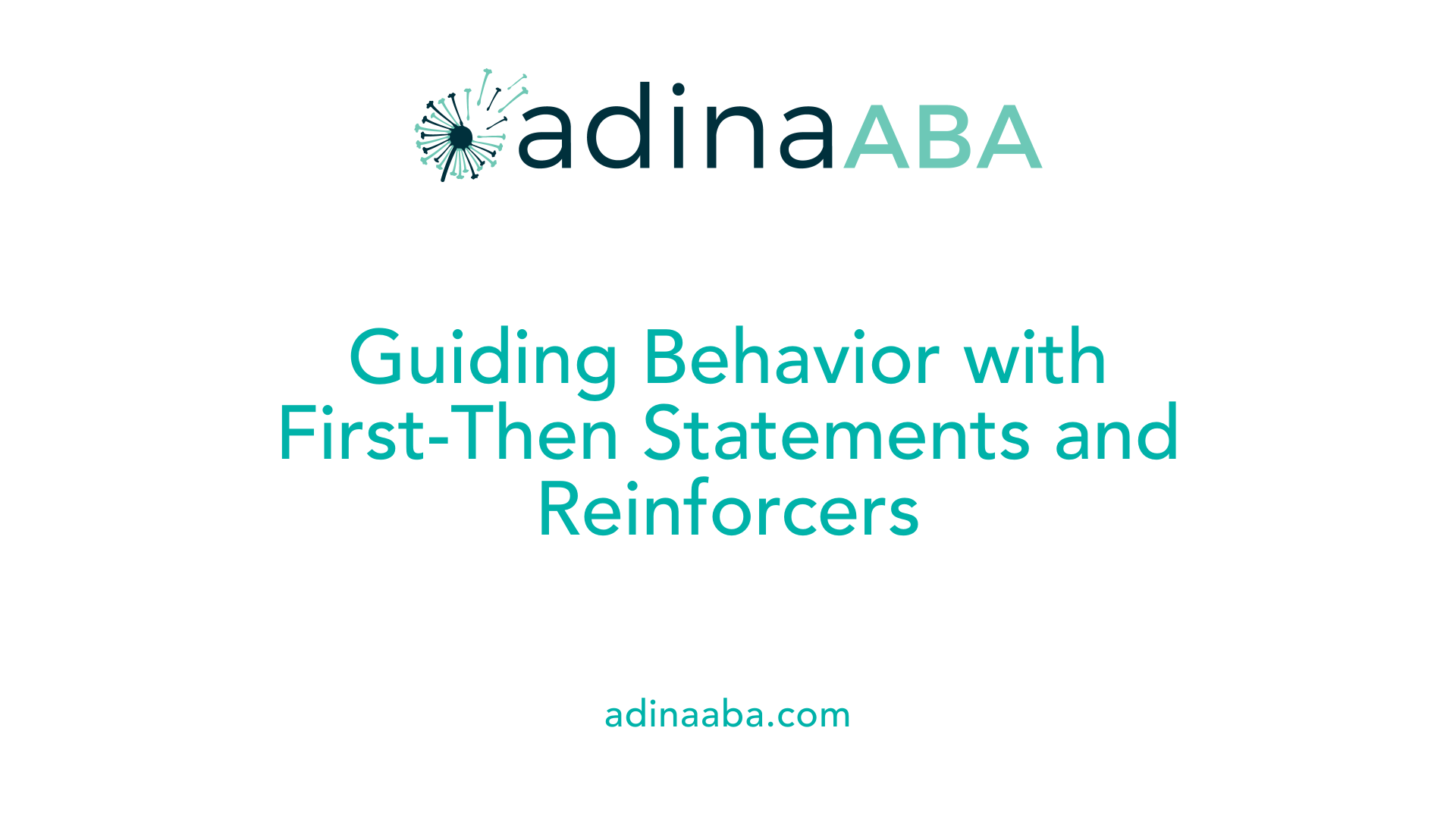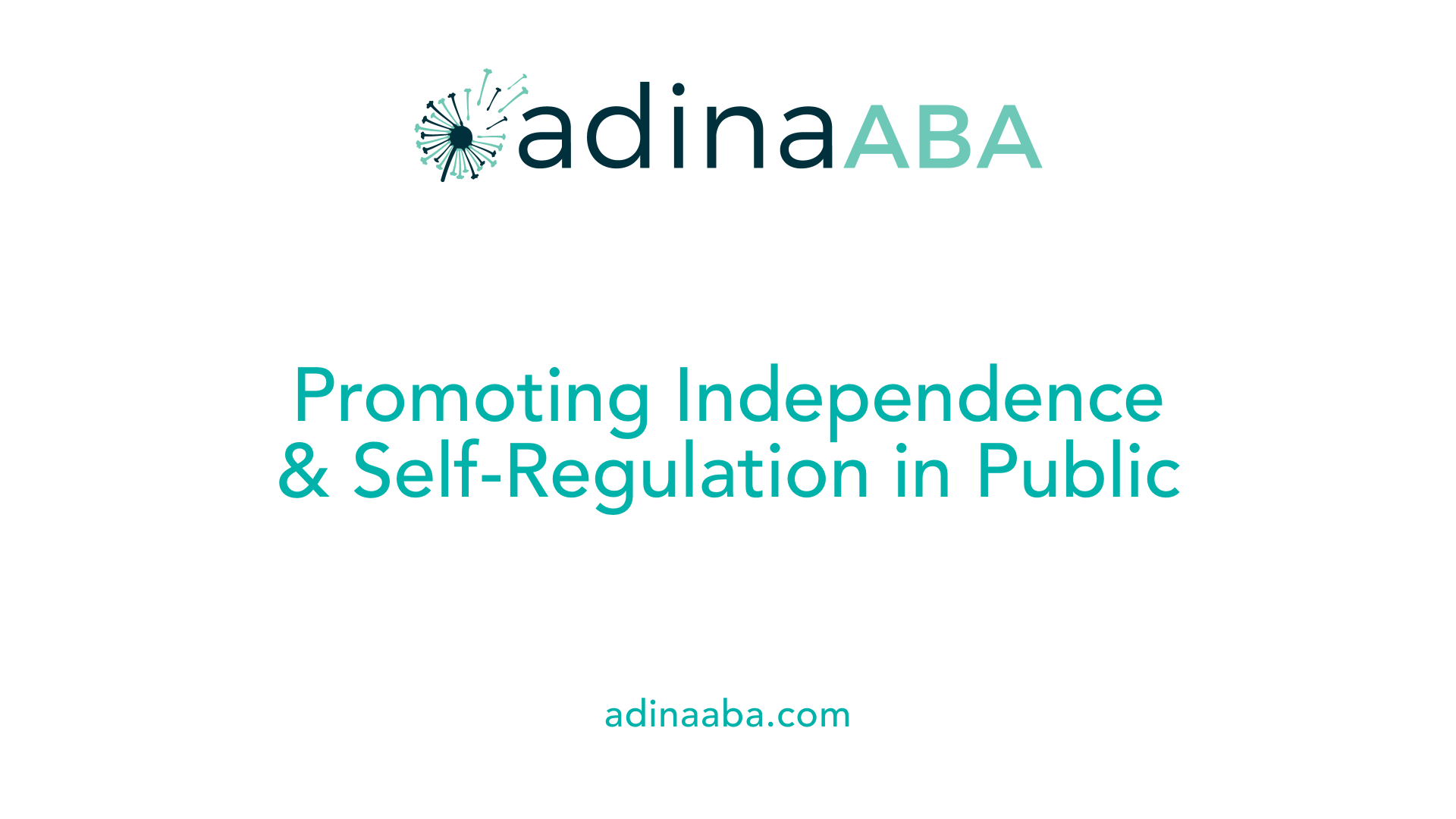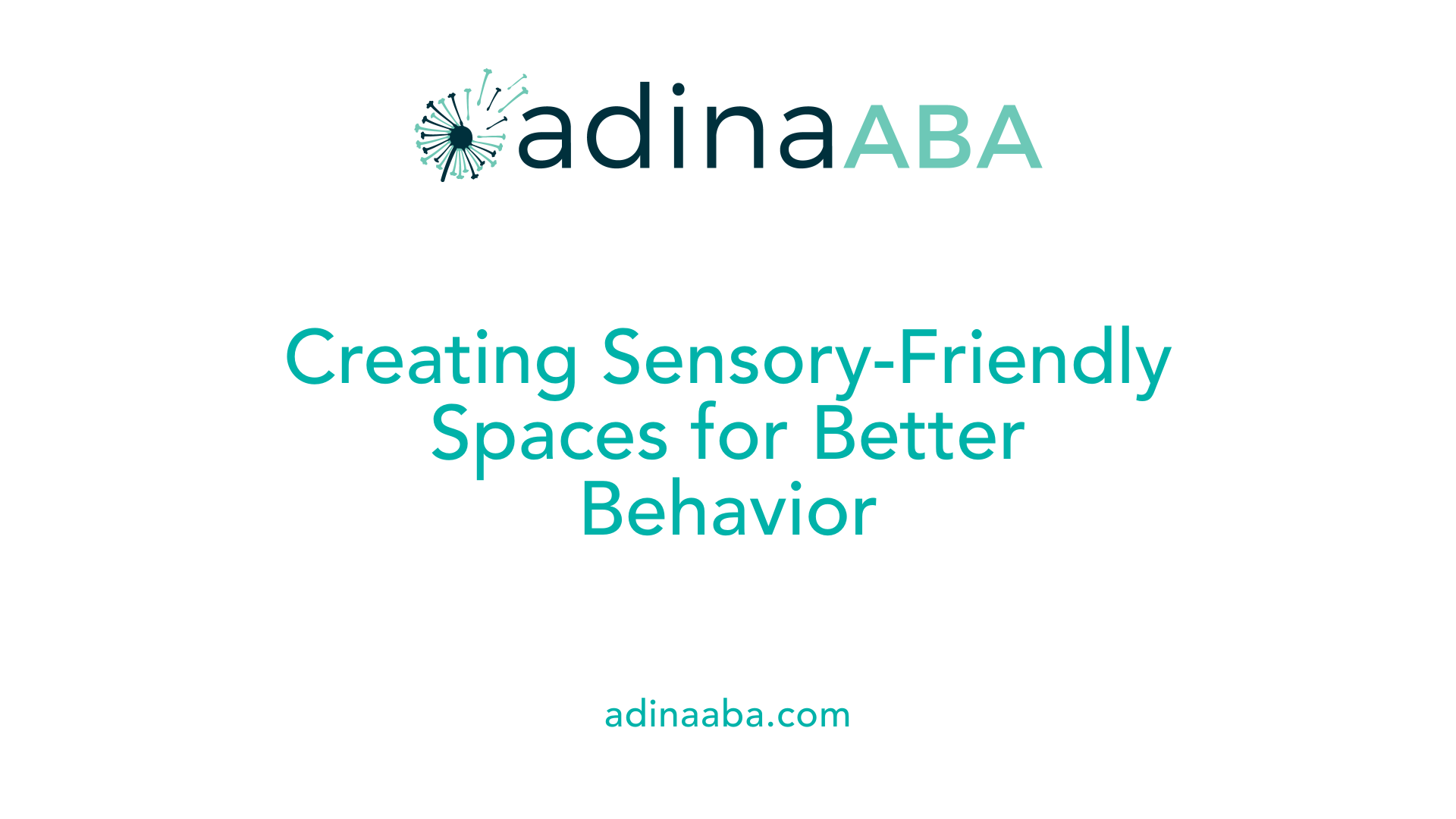How to Handle Public Behavioral Challenges Using ABA Strategies

Understanding ABA and Its Role in Managing Public Behavior
Applied Behavior Analysis (ABA) is a science-based approach that helps children develop appropriate social behaviors, enhance communication skills, and navigate public environments with confidence. Grounded in fundamental principles of learning and behavior, ABA offers a suite of evidence-based techniques that can be tailored to individual needs, making it especially effective for children with autism spectrum disorder (ASD) and other behavioral challenges. By systematically applying these strategies, parents, teachers, and caregivers can foster positive social interactions, reduce problematic behaviors, and support children in becoming more independent while out in public.
Pre-Planning with Visual Supports

How can ABA strategies be applied to manage and support children's behavior in public settings?
ABA techniques are highly effective in guiding children's behavior in public spaces, helping to create a smooth experience for both the child and caregivers. One of the foundational steps involves observing the child carefully to identify specific triggers and environmental factors that influence their actions.
To support children in understanding what is expected, visual supports such as social stories, visual schedules, and timers are invaluable. These tools help children comprehend routines, upcoming transitions, and social norms, significantly reducing anxiety and uncertainty.
Positive reinforcement, including preferred items and activities, encourages children to exhibit desirable behaviors. For example, a child might earn extra screen time or a favorite toy for complying with rules during an outing.
Another crucial aspect is teaching functional communication skills, enabling children to express their needs and discomforts rather than resorting to disruptive behaviors. This approach promotes independence and reduces frustration.
What practical techniques can be used to handle public behavioral challenges using ABA?
Handling behavioral challenges in public with ABA involves proactive and reactive strategies. Before the outing, caregivers can pre-teach expected behaviors through social stories and visual schedules tailored to the specific environment.
Using visual supports like picture charts or video modeling helps prepare children for what they will see and do, easing transitions and reducing unexpected reactions.
Reinforcement plays a central role—praising or rewarding children when they follow rules or use communication strategies reinforces positive behaviors.
Redirecting attention from undesirable to positive activities is another effective technique. When a child begins to engage in challenging behavior, calmly redirecting their focus to an alternative activity can prevent escalation.
Clear, simple instructions such as “Hold my hand,” or “Use your inside voice,” improve compliance, especially when supported by prompting and fading techniques to gradually guide independence.
Employing timers and countdowns sets clear expectations for transitions, giving children warning before changing activities, which helps in reducing anxiety and resistance.
Behavior contracts or first-then statements clarify anticipated actions and rewards, fostering understanding and cooperation.
In addition, calming responses—including sensory breaks and appropriate use of sensory tools—help children self-regulate during overwhelming situations.
How does ABA support individuals with behavioral challenges in public settings?
ABA provides tailored strategies to support individuals facing behavioral challenges outside the home. In public environments such as malls, parks, or restaurants, ABA techniques focus on decreasing problematic behaviors and increasing socially appropriate actions.
One approach involves creating individualized behavior plans based on assessments that identify triggers and target skills.
Using visual supports like schedules or social stories helps prepare individuals for upcoming activities and reduce anxiety.
In school or community-based programs, ABA experts often collaborate with educators and caregivers to implement consistent strategies across environments.
Modern ABA emphasizes teaching through naturalistic, play-based methods, making skill acquisition engaging and contextually relevant. This aids in generalizing learned behaviors from one setting to another.
Staff training is also vital—educators and caregivers learning specific ABA techniques ensures that responses are supportive and consistent.
What are the common interventions for managing behavioral challenges with ABA?
A variety of interventions are used to manage behavioral challenges effectively. Positive reinforcement remains the cornerstone, helping to increase instances of desired behaviors.
Visual supports, such as picture schedules and social stories, assist children in understanding routines and expectations, especially in new or complex situations.
Prompting guides children towards the appropriate behavior, with fading techniques gradually reducing assistance to foster independence.
Behavior chaining is employed to teach complex tasks by teaching each step sequentially, allowing children to master each component before moving to the next.
Behavior contracts provide structured expectations, with rewards or consequences clearly defined.
Extinction procedures, which involve withholding reinforcement for challenging behaviors, can be effective but require careful implementation to avoid extinction bursts.
Modeling demonstrates desired behaviors, enabling imitation and skill acquisition.
Redirection shifts a child's attention away from problematic behavior toward engaging and appropriate activities.
Script fading involves gradually reducing the use of prompts or scripts used during social interactions, helping individuals develop spontaneous communication.
Overall, customizing interventions to the child's needs, ongoing data collection, and caregiver involvement are essential for success.
Using First-Then Statements and Reinforcers to Guide Behavior

How can ABA strategies be applied to manage and support children's behavior in public settings?
ABA strategies are highly effective when it comes to managing children's behaviors outside the home, particularly in public spaces. The first step involves observing and understanding what triggers challenging behaviors, such as sensory overload or transitions. Using visual supports like social stories, schedules, and timers helps children grasp what to expect, easing anxiety and preventing disruptive behaviors.
Reinforcing positive behaviors through specific and consistent praise or preferred items motivates children to repeat those actions. Functional communication training allows children to express needs appropriately, reducing tantrums.
Proactive planning, including pre-teaching expected behaviors using visual tools, empowers children to behave suitably during outings. These strategies, combined with structured routines and reinforcement, foster independence and social skills.
What practical techniques can be used to handle public behavioral challenges using ABA?
Effective ABA techniques for addressing behavioral challenges in public settings include identifying what precedes the unwanted behavior—often called antecedents—and modifying the environment to prevent it.
Pre-emptive strategies include using visual schedules or social stories to clarify expectations, especially before entering new environments. Implementing First-Then statements like, "First, we walk through the store without running, then we can pick a snack," provide clear, predictable structures.
Reinforcers such as preferred toys or activities can be offered as rewards for appropriate behavior. When behaviors occur, redirection helps shift attention to positive alternatives. Using prompts and providing short, clear instructions like "Hold my hand" or "Use an inside voice" guide compliance.
Timers and countdowns serve as cues for upcoming transitions, making them smoother. Calming responses and sensory breaks can also reduce agitation. Together, these techniques promote cooperation and reduce disruptive incidents.
How does ABA support individuals with behavioral challenges in public settings?
ABA provides a framework for understanding and modifying behaviors in external environments. It begins with assessing the child's specific triggers and needs.
In public, ABA strategies involve the use of individualized plans that include visual supports, social stories, and teaching appropriate social interactions, like greeting others or taking turns.
Reinforcement remains central—praising or rewarding positive social interactions encourages continued use of these skills. For children with sensory sensitivities, ABA may incorporate sensory diets or desensitization techniques to help them cope better.
Training caregivers and staff also ensures consistency in responses, simplifying the child's experience across settings, and reinforcing skills learned in therapy.
What are the common interventions for managing behavioral challenges with ABA?
The core interventions in ABA focus on reinforcing desirable behaviors while reducing problematic ones. Positive reinforcement, such as offering a preferred activity after a successful transition or social interaction, increases the likelihood of these behaviors occurring again.
Visual supports like picture schedules and modeling help teach new skills effectively. Prompting guides children toward the correct behavior, with fading strategies gradually reducing assistance to foster independence.
Behavior chaining teaches complex sequences by breaking them down into steps, making learning manageable. Behavior contracts formalize expectations and consequences, while extinction minimizes reinforcement for undesired behaviors, decreasing their frequency.
In all, customizing these interventions based on individual needs ensures a comprehensive approach that promotes meaningful progress.
| Strategy | Description | Example |
|---|---|---|
| Positive Reinforcement | Reward for desired behaviors to increase their frequency | Giving praise or a preferred toy after sharing |
| Visual Supports | Using visual cues to teach and prompt behaviors | Picture schedules for daily routines |
| Prompting & Fading | Providing guidance and gradually reducing assistance | Hand-over-hand guidance, then fading prompts |
| Behavior Chaining | Teaching complex tasks in steps | Brushing teeth step-by-step |
| Redirection | Shifting attention from undesirable behavior to a positive one | Redirecting a tantrum into a calming activity |
| Extinction | Removing reinforcement for targeted behaviors | No attention for tantrums |
| Social Skills Training | Teaching social rules and cues through role-play | Practicing greetings and sharing ideas |
By integrating these strategies, caregivers and professionals can better support children's behavioral development in public contexts, promoting safety, social interaction, and independence.
Managing Transitions with Timers and Visual Cues
 When children with autism or other behavioral challenges are in public settings, transitions from one activity to another can often trigger challenging behaviors. Using visual cues, timers, and countdowns helps prepare children for these changes, making the process smoother and reducing anxiety.
When children with autism or other behavioral challenges are in public settings, transitions from one activity to another can often trigger challenging behaviors. Using visual cues, timers, and countdowns helps prepare children for these changes, making the process smoother and reducing anxiety.
How can ABA strategies be applied to manage and support children's behavior in public settings?
ABA strategies can be highly effective outdoors or in busy environments by observing and identifying what triggers problematic behaviors. Visual supports like social stories, visual schedules, and timers give children clear expectations and a sense of predictability. For example, showing a visual countdown before leaving a park or a mall helps children understand that a transition is upcoming. Positive reinforcement, such as praise or preferred items, encourages cooperation, while redirection helps shift attention from disruptive behaviors to more appropriate activities.
What practical techniques can be used to handle public behavioral challenges using ABA?
Several practical ABA techniques facilitate better behavior management in public. These include:
- Pre-Teaching Expectations: Using social stories or visual schedules to explain what will happen during the outing.
- Visual Supports: Pictures, charts, and schedules clarify routines and reduce uncertainty.
- Timers and Countdowns: Visual timers show how much time remains in an activity, easing the transition.
- Clear, Short Instructions: Simple commands, like 'Hold my hand' or 'Use your inside voice,' guide behavior effectively.
- Reinforcement and Redirection: Preferred items reward good behavior, and redirecting attention to positive activities minimizes disruption.
- Behavior Contracts and First-Then Statements: These provide structure, for example, 'First, we walk without running; then, we can get a snack.'
- Sensory Strategies: Incorporating sensory diets or calming tools can help manage sensory overload often experienced outdoors.
How does ABA support individuals with behavioral challenges in public settings?
ABA provides a framework to understand and modify behaviors by addressing environmental triggers. Tailored interventions focus on teaching functional communication skills, social cues, and self-regulation techniques in real-life contexts. Visual supports and structured routines enhance understanding and independence. In schools or community outings, ABA-trained staff work alongside families to implement consistent responses, helping children navigate varied environments with increased confidence.
What are the common interventions for managing behavioral challenges with ABA?
ABA interventions are diverse yet targeted. Common techniques include:
| Technique | Description | Purpose |
|---|---|---|
| Positive Reinforcement | Reward desired behaviors to increase their frequency | Promote good behaviors in public |
| Visual Modeling | Use charts, pictures, or videos to demonstrate behaviors | Teach social skills and expectations |
| Prompting and Fading | Guide behaviors initially, then gradually reduce prompts | Develop independence |
| Behavior Chaining | Teach complex tasks as a series of small steps | Manage multi-step activities |
| Redirection | Shift attention from undesirable to positive behaviors | Decrease tantrums |
| Behavior Contracts | Formal agreements outlining expectations and rewards | Foster accountability |
| Extinction | Withhold reinforcement to reduce behavior | Address challenging behaviors |
In addition, ongoing data collection helps therapists and families evaluate progress and refine strategies. Regular training for caregivers ensures consistency across environments.
Support in the Local Community
In Atlanta, Georgia, several ABA providers specialize in community-based support. These agencies collaborate with families to create individualized behavior plans, ensuring children can participate safely and happily in public outings. They also offer parent training to help implement strategies at home and in the community, promoting generalization of skills.
Final Thoughts
Effective management of public behaviors in children with autism relies on systematic ABA techniques, including visual supports, timers, reinforcement, and social skills training. With proper planning and consistent support, children can develop independence, confidence, and better social interactions, making outings more enjoyable for everyone involved.
Teaching Social Skills Through Role-Playing and Modeling

How can ABA strategies be applied to manage and support children's behavior in public settings?
ABA methods are highly effective in guiding children through appropriate social behaviors in public. To start, therapists and parents observe what triggers challenging behaviors, such as loud noises or unstructured environments. Using visual tools like social stories and visual schedules prepares children for what to expect, reducing anxiety. Timers and countdowns help signify transition times, providing warnings before changing activities.
Positive reinforcement plays a crucial role; for example, rewarding a child with praise or a preferred item when they behave appropriately encourages repetition. Redirecting a child's attention from disruptive behaviors to acceptable ones, like engaging in a game or using a communication device, supports smoother interactions. Clear, simple instructions—like 'Hold my hand' or 'Use your inside voice'—are more likely to be followed. Overall, these strategies create a structured environment that promotes positive engagement in public.
What practical techniques can be used to handle public behavioral challenges using ABA?
Handling public behaviors involves proactive planning. Recognizing triggers such as crowded areas or long waits allows caregivers to preempt issues. Visual supports, like social stories explaining expected behaviors, can be reviewed beforehand. Reinforcement with preferred activities, like earning video game time for following rules, motivates children to stay compliant.
Prompting and fading are used to guide children towards correct actions, while behavior chaining teaches complex routines step-by-step. Behavior contracts can formalize expectations, and First-Then statements clarify what must happen before a desired activity, like 'First, we sit quietly, then we can go to the park.' Calm responses, sensory breaks, and functional communication training help de-escalate situations and teach children to express their needs appropriately.
How does ABA support individuals with behavioral challenges in public settings?
ABA fosters independence and social competence in children facing behavioral challenges in public. Intervention plans are individualized, focusing on understanding each child's unique triggers and strengths. Strategies include teaching communication skills to express emotions or needs, which reduces frustration-induced behaviors.
In school or community environments, ABA services often include training for staff and caregivers. Visual cues, structured routines, and social skills training—such as greeting others or waiting in line—are embedded into everyday activities.
Modern ABA emphasizes reinforcement of positive social interactions through natural play and social routines, helping children navigate public settings more confidently. These approaches aim not just to reduce problematic behaviors but also to build lifelong social skills.
What are the common interventions for managing behavioral challenges with ABA?
ABA interventions are diverse and tailored to the individual. Reinforcement, both positive and negative, encourages desirable behaviors; for example, praise or preferred items reward good choices.
Visual supports like picture schedules and video modeling teach new skills and clarify expectations. Prompting guides children toward desired responses, with fading techniques gradually reducing assistance to encourage independence. Complex behaviors are broken into steps via behavior chaining, making learning manageable.
Behavior contracts provide a clear outline of expected behaviors and possible rewards or consequences, ensuring accountability. Extinction involves withholding reinforcement for challenging behaviors, aiming to decrease their occurrence over time.
In combination, these interventions create a comprehensive approach to reduce problematic behaviors while promoting skills essential for social participation.
Developing Social Skills and Building Peer Interactions

How can ABA strategies be applied to manage and support children's behavior in public settings?
ABA strategies are highly effective in helping children navigate public environments successfully. First, therapists and parents observe what triggers challenging behaviors, such as overstimulation or transitions. Using visual supports like social stories, visual schedules, and timers sets clear expectations, helping children understand what will happen next. These tools aid in managing anxiety and reducing disruptive behaviors.
Positive reinforcement plays a crucial role. For example, rewarding a child with a preferred activity or praise when they follow rules or respond appropriately encourages continued positive behavior. When problems arise, redirection—guiding the child towards acceptable behaviors—and modeling desired actions maintain focus on solutions. Clear, short instructions like 'Hold my hand' or 'Use inside voice' also improve compliance.
In addition, functional communication training teaches children to express their needs, decreasing frustration. Sensory tools and calming techniques, like sensory breaks, help children self-regulate during outings. Collectively, these strategies foster a supportive environment where children learn appropriate behaviors and develop independence in public spaces.
What practical techniques can be used to handle public behavioral challenges using ABA?
Handling public challenges with ABA involves proactive and reactive approaches. Before outings, pre-teaching expectations with visual supports prepares children. During outings, structured routines with visual cues provide predictability, easing transitions. Reinforcing positive behaviors—such as earning praise or rewards for following rules—encourages children to repeat them. When children become upset or disruptive, redirection from undesirable to positive actions helps manage behavior effectively. Prompting and fading techniques guide children to perform desired behaviors, gradually reducing assistance as they become more independent. Clear, concise instructions increase understanding and compliance. Using timers or countdowns offers warnings before transitions, which minimizes anxiety. Lastly, establishing behavior contracts—agreements outlining expected behaviors and associated rewards—adds structure. Employing calming responses, sensory breaks, and functional communication strategies ensures that behavioral challenges are addressed compassionately and systematically.
How does ABA support individuals with behavioral challenges in public settings?
ABA provides a structured approach to managing behavioral issues by focusing on individual triggers and teaching alternative behaviors. For children with autism or behavioral difficulties, ABA emphasizes reinforcing positive actions and minimizing negative ones.
In school environments, ABA techniques can include one-on-one or group interventions, utilizing visual supports and structured routines to improve communication and social skills. Teachers are trained to implement strategies like prompting, reinforcement, and reinforcement fading.
For community outings, ABA encourages naturalistic teaching—using everyday activities to promote skills—supporting gradual independence while maintaining safety and engagement. The emphasis is on creating consistent responses across settings, involving caregivers and educators collaboratively. Functional behavior assessments identify specific issues, allowing for tailored interventions that support social participation and reduce problematic behaviors.
What are the common interventions for managing behavioral challenges with ABA?
Key ABA interventions for behavioral management include positive reinforcement, which involves rewarding desirable behaviors to promote their recurrence. Visual supports, like picture schedules or social stories, clarify expectations and teach new skills. Prompting guides individuals step-by-step toward a behavior, while fading gradually reduces assistance to promote independence. Behavior chaining teaches complex tasks by linking simple steps, making them easier to learn. Behavior contracts formalize expectations and consequences, providing clarity and motivation. Extinction involves withholding reinforcement for undesirable behaviors, though it may lead to an initial increase known as an extinction burst. Modeling demonstrates appropriate behaviors for imitation, and redirection shifts attention away from negative behaviors to positive alternatives. Script fading uses social scripts to practice interactions like greetings or ordering food. All these strategies, tailored to individual needs, foster positive behavioral change and social competence in public settings.
Fostering Independence and Promoting Self-Regulation in Public

How can ABA strategies be applied to manage and support children's behavior in public settings?
ABA (Applied Behavior Analysis) offers practical and effective methods for managing children's behaviors during outings or in public environments. The first step involves observing and identifying specific triggers such as noise, crowding, or unfamiliar routines that may lead to challenging behaviors.
To prepare children, parents can use visual supports like social stories and visual schedules that clarify what to expect during the outing. Timers and countdowns are helpful tools, offering warnings before transitions, which helps reduce anxiety and resistance.
Positive reinforcement plays a crucial role; rewarding desired behaviors with preferred items or activities encourages children to repeat those actions. For instance, praising a child for walking calmly or following instructions can reinforce good behavior.
Redirection and modeling are additional techniques. If a child begins to act out, gently redirect their attention to a more appropriate activity, and demonstrate positive social interactions like greeting others or waiting patiently.
Consistent use of prompts, such as guiding a child with verbal cues or physical assistance, with gradual fading, supports independence, leading to less reliance on prompts over time.
Employing behavior contracts, where expectations and rewards are clearly outlined, helps establish predictability and structure, making children feel more secure.
Furthermore, calming strategies such as sensory breaks or the use of sensory objects can help children regulate their emotions and sensory input, reducing the likelihood of behavioral issues.
In conclusion, applying ABA strategies in public involves a combination of planning, visual supports, reinforcement, and calming techniques, which together foster better self-regulation and appropriate social behaviors in children.
What practical techniques can be used to handle public behavioral challenges using ABA?
When faced with behavioral challenges in public, a proactive approach grounded in ABA is best. Firstly, identifying antecedents—triggers that precede problematic behaviors—allows for targeted intervention.
Pre-teaching expectations with visual cues or social stories prepares children for the outing, reducing uncertainty that might trigger difficulties. During the activity, providing clear, short instructions such as 'Hold my hand' or 'Use inside voice' makes compliance easier.
Reinforcing positive behaviors through preferred items, praise, or privileges motivates children to behave appropriately. For example, earning time on a favorite device for following rules is an effective reward.
If a child begins to act disruptively, redirecttheir attention toward positive alternatives, such as engaging in a different activity or using a sensory tool. Prompting—giving hints or assistance—and gradually reducing these prompts helps promote independence.
Timers and countdowns serve as helpful cues for transitioning between activities, which diminishes resistance to change.
Behavior contracts can also delineate positive behaviors and associated rewards, offering structure.
Incorporating calming responses, like deep breathing or sensory breaks using calming objects, helps de-escalate distress and manageable behaviors.
Finally, consistently applying these techniques helps children learn expectations and develop self-control, making outings more successful.
How does ABA support individuals with behavioral challenges in public settings?
ABA provides tailored strategies that aim to improve behavior and self-regulation in children with challenges, especially in busy or unpredictable environments.
By conducting functional behavior assessments, practitioners identify specific triggers and develop personalized intervention plans.
ABA techniques such as reinforcement of positive behaviors, visual supports, and systematic prompting are used to teach appropriate responses and reduce problematic behaviors.
In environments like schools or community centers, ABA often involves training staff and caregivers, ensuring consistency across settings. Visual supports—like picture schedules and social scripts—help children understand routines and social cues.
Modern ABA emphasizes naturalistic, play-based approaches that incorporate real-world activities, making learning relevant and engaging.
These strategies support children’s social skills and independence, gradually helping them navigate public environments with less difficulty. Functional communication training, a core ABA component, teaches children how to express needs instead of exhibiting challenging behaviors.
Overall, ABA nurtures behavioral flexibility and emotional regulation, enabling children to participate more comfortably and competently in public.
What are the common interventions for managing behavioral challenges with ABA?
ABA interventions encompass a variety of scientifically-backed techniques:
| Intervention Technique | Description | Application Example |
|---|---|---|
| Positive Reinforcement | Reward for desired behaviors | Praising or giving a preferred item when a child follows instructions |
| Visual Supports | Charts, pictures, videos | Using picture schedules to explain daily routines |
| Prompting and Fading | Guidance to encourage correct behavior, then reducing assistance | Providing hand-over-hand guidance, then fading to verbal prompts |
| Behavior Chaining | Breaking complex tasks into steps | Teaching handwashing step-by-step |
| Behavior Contracts | Formal agreements on expectations | Contract outlining rewards for staying seated during errands |
| Extinction | Withholding reinforcement for undesired behaviors | Ignoring tantrums to reduce frequency |
| Modeling | Demonstrating desired behavior | Showing how to greet politely |
| Redirection | Shifting focus from undesirable to positive | Turning attention from a tantrum to a calming activity |
| Script Fading | Gradually removing prompts in social scripts | Transitioning from guided practice to independent conversation |
These interventions are tailored to individual needs, addressing specific behaviors and promoting consistent progress. Their effectiveness depends on careful implementation and ongoing data collection, enabling continuous adjustment and ensuring optimal support for children facing behavioral challenges.
Creating Sensory-Friendly Environments and Handling Overload

How can ABA strategies be applied to manage and support children's behavior in public settings?
ABA strategies are highly effective in promoting positive behaviors and managing challenges during public outings. The process begins with observing and identifying the specific triggers or environmental factors that influence a child's behavior. Visual supports such as social stories, visual schedules, and timers are essential tools that prepare children by clearly explaining expectations and helping them understand upcoming transitions. This proactive approach reduces uncertainty and anxiety, common sources of challenging behaviors.
Using positive reinforcement, like preferred items or praise, encourages children to repeat good behaviors. When issues arise, techniques such as redirection or modeling provide gentle guidance toward more appropriate actions. Prompts, behavioral cues, and simple instructions—think 'Hold my hand' or 'Use your inside voice'—further support compliance and understanding.
Overall, ABA approach in public settings emphasizes understanding individual needs, reducing triggers, and teaching alternative, functional behaviors that support safe and enjoyable outings.
Empowering Through ABA: Enhancing Public Behavior and Independence
By systematically integrating ABA techniques such as visual supports, reinforcement, prompting, and sensory management, caregivers and professionals can significantly improve children's ability to behave appropriately in public. Emphasizing collaboration, ongoing data collection, and individualized plans ensures that interventions are effective and adaptable to each child's evolving needs. As children gain skills in social interactions, self-regulation, and independence, they become more confident and comfortable in public environments. Ultimately, ABA empowers families to foster positive experiences, promote inclusion, and support children in achieving greater autonomy and social participation.
References
- How to Use ABA Strategies in Public Settings
- ABA Techniques: Strategies for Behavior Analysts - GSEP Blog
- How to Advocate for ABA Therapy Services in School Settings
- Overcoming Challenges and Celebrating Successes in ABA Therapy
- ABA Techniques: Strategies for Behavior Analysts - GSEP Blog
- How to Use ABA Strategies in Public Settings
- Overcoming Challenges and Celebrating Successes in ABA Therapy
- ABA Therapy Examples, Definition & Techniques
- Applied Behavior Analysis in Children and Youth with Autism ...
- ABA Techniques: Strategies for Behavior Analysts - GSEP Blog
More Resources
Expert Clinicians
Get started today ->



.jpg)


.jpg)